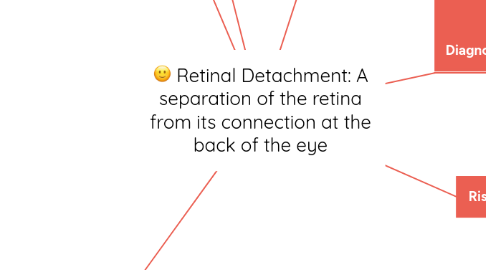
1. Signs and symptoms:
1.1. blurred vision
1.2. Photopsia
1.3. Reduced peripheral vision
1.4. Curtain like shadow
1.5. Tiny specs that seem to drift through your field of vision
2. Treatment Surgery:
2.1. 1. Viitrectomy
2.2. 2.Replantation
2.3. 3.Cryosurgery
2.4. 4.Scleralbuckle
2.5. 5.Laser surgery
3. Nursing care
3.1. Primary Prevention
3.1.1. Patients with known risk factors for retinal detachment should have serial dilated fundus examinations with scleral depression, often yearly.
3.1.2. Protective eyewear is recommended for individuals with high myopia that participate in contact sports
3.1.3. Patients undergoing cataract surgery should be counseled about the importance of reporting symptoms of retinal tears and detachments.
3.2. Hospital Care
3.2.1. Prepare the patient for surgery. Instruct the patient to remain quiet in prescribed position, to keep the detached area of the retina in dependent position. Patch both eyes. Wash the patient’s face with antibacterial solution. Instruct the patient not to touch the eyes to avoid contamination. Administer preoperative medications as ordered.
3.2.2. Take measures to prevent postoperative complications. Caution the patient to avoid bumping head. Encourage the patient no to cough or sneeze or to perform other strain-inducing activities that will increase intraocular pressure.
3.2.3. Encourage ambulation and independence as tolerated.
3.2.4. Administer medication for pain, nausea, and vomiting as directed.
3.2.5. Provide quiet diversional activities, such as listening to a radio or audio books.
3.3. Discharge Care/Info
3.3.1. Patient Education The patient should be informed about the symptoms of a retinal detachment, retinal tear, or related peripheral vitreoretinal disease and advised to return immediately if the symptoms occur. Prompt recognition of symptoms will increase the chances for successful surgery and better postoperative visual acuity.
3.3.2. Teach proper technique in giving eye medications.
3.3.3. Advise patient to avoid rapid eye movements for several weeks as well as straining or bending the head below the waist.
3.3.4. Advise patient that driving is restricted until cleared by ophthalmologist.

